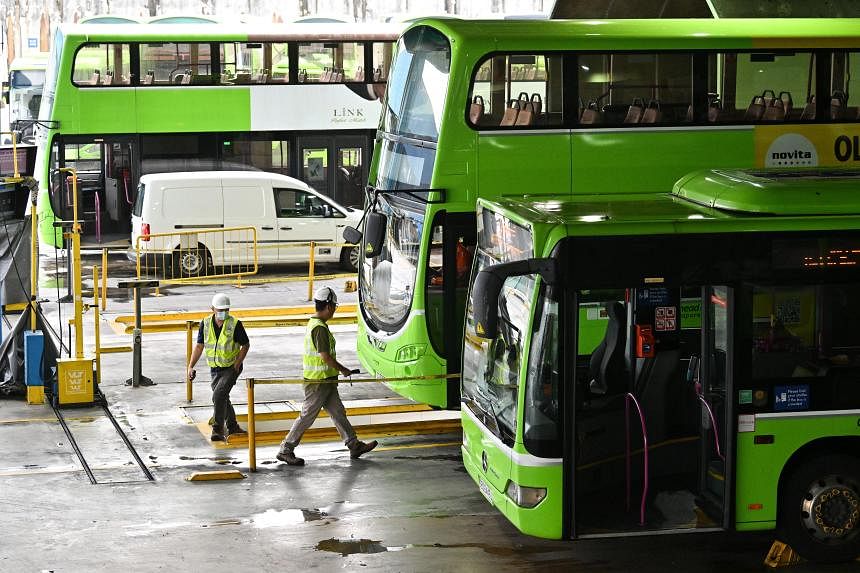SINGAPORE - As Singapore gears up to run more electric buses, the Land Transport Authority (LTA) is looking for ways to deal with emergencies that may arise, like such buses catching fire at a busy depot.
In such a scenario, what would be the best way to remove the burning bus, put out the fire and prevent damage to other buses or property?
The LTA on April 17 called for proposals for ways to quickly remove a burnt electric bus from a multi-storey depot and submerge it into a water tank to prevent a fire from reigniting. It is seeking a contractor to provide equipment that can fulfil the task, and have the equipment operational by March 2025.
Responding to queries, the LTA said that even though the risk of electric bus fires is low, it wanted to “explore different equipment” to manage battery fires because the nature of such fires is different from conventional ones.
Lithium-ion, which is the most prevalent battery technology used to power electric vehicles (EVs), burns at around 2,760 deg C – hot enough to melt steel and concrete. Diesel engines, in contrast, burn at around 700 deg C.
“Even when the e-bus fire is extinguished, there remains a possibility of reignition, which could be a result of sparks created by parts of the burnt bus being in contact with the ground or depot structures during the removal process,” the LTA said on its Land Transport Innovation Portal, describing the challenge.
The LTA also said the additional equipment is meant to enhance existing fire mitigation measures such as water sprinklers and water curtains to prevent fire from spreading to other buses and parts of the depot.
By 2030, half of Singapore’s public bus fleet will be electric. The first batch of the 360 electric buses that the LTA has ordered will start arriving from the second half of 2024, and an initial 60 buses were deployed in 2018 under a pilot scheme to test out the technology.
Public buses are maintained and parked at bus depots when they are not in service. EV chargers are being fitted in more depots as the public electric bus fleet expands.
New depots, like the upcoming ones in Sengkang West, Gali Batu, Yishun and the East Coast Integrated Depot, are multi-storey buildings rather than flat single-storey set-ups with open-air parking. Buses are parked on the upper floors, with the ground floor housing the maintenance workshop.
The software and design of EVs can detect and isolate faults in the batteries before a fire occurs. However, there have been reports of EV fires overseas.
According to experts, after an EV fire has been put out, there is a risk that the heat remaining in the battery cells can be high enough to cause reignition. This helps to explain why the LTA wants to remove the burnt electric bus and submerge it in a water tank to bring down the temperature.
In its call, the LTA sought solutions that can extract the burnt EV quickly without any part of the vehicle touching the ground or the depot’s structures. After that, the equipment must be able to place the damaged vehicle in a water tank that will be located away from the depot.
The LTA’s call did not specify the size of the equipment or water tank, but these would have to be able to cope with a double-deck electric bus, which weighs around 15,422kg – the weight of nearly 12 typical family sedans.
Mr Amrit Mirchandani Changaroth, a mechanical engineer who is certified to handle high-voltage EV batteries, said the challenge may be too complex to have a feasible solution as the size and weight of a bus make it more difficult to deal with, compared with an electric car that catches fire.
With burnt electric cars, isolator blankets are used to cover the entire vehicle to prevent fresh air from getting in contact with the hot batteries to fuel another fire.
Mr Changaroth said that even if there is a blanket large enough to cover a double-decker bus, it will be extremely difficult to do so manually.
“For the submersion into the tank to be effective, the chamber also needs to be designed to minimise air intrusion,” he added.
Given the complexity of transporting the damaged vehicle down parking ramps, he believes it may be safer to leave the vehicle in situ for as long as 72 hours for the temperature inside the battery cells to drop sufficiently before trying to remove it from the building.
There are 262 electric buses in Singapore as at March 31. This includes both public and private buses.


